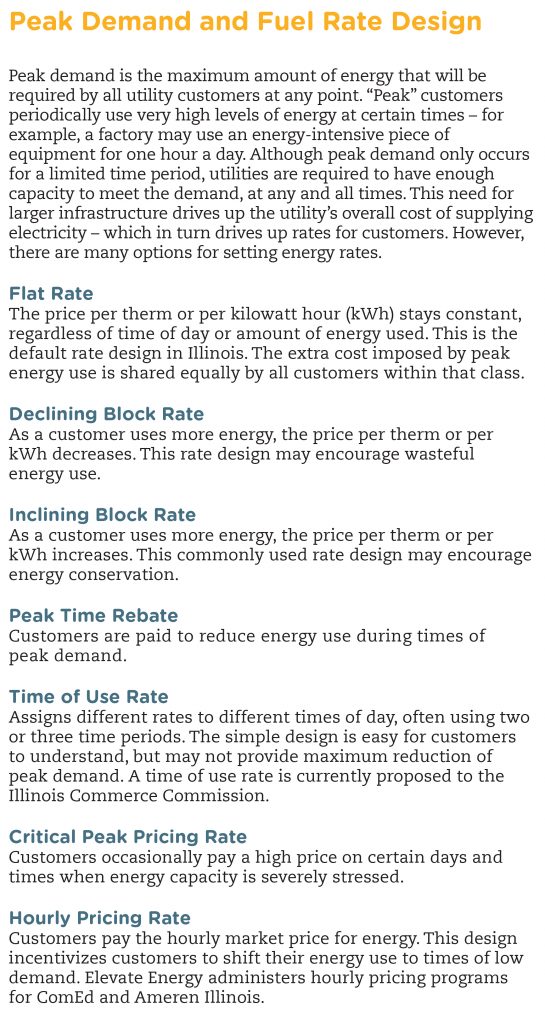A Primer on Energy Use and Rate Design
This post is written by Marcella Bondie Keenan, policy fellow at Elevate Energy.
Rate design is the method by which an energy utility calculates fuel charges and customer charges. This post explains how these charges are calculated and how rate design can help keep energy costs affordable for low income or low-use customers.
First, How Are Energy Rates Calculated?
Investor-owned electric and natural gas utilities are regulated by state agencies such as the Illinois Commerce Commission. In some places, energy is supplied by a co-op or a third-party supplier, but this post focuses on investor-owned utilities.
State energy regulators determine how much revenue a utility can collect from customers based on how much it costs the utility to supply energy. Once regulators approve how much total revenue the utilities can collect, they decide how to allocate the costs across specific customer classes, typically categorized as residential, small commercial, large commercial, and industrial. The resulting rates are intended to reflect the varying costs for supplying energy to each customer class. There are many options for setting energy pricing structures (see sidebar).
 For each customer class, the rate design may split customers’ utility bills into various charges, including a fuel (or supply) charge and a customer (or service) charge. The fuel charge is based on how much energy an individual customer uses, and it varies from month to month. The customer charge is unrelated to the amount of energy that the customer uses, and generally is a fixed monthly price to cover the cost of customer service. The customer charge typically covers administrative functions such as billing and collection.
For each customer class, the rate design may split customers’ utility bills into various charges, including a fuel (or supply) charge and a customer (or service) charge. The fuel charge is based on how much energy an individual customer uses, and it varies from month to month. The customer charge is unrelated to the amount of energy that the customer uses, and generally is a fixed monthly price to cover the cost of customer service. The customer charge typically covers administrative functions such as billing and collection.
Changing the rate design does not affect the utility’s overall revenue. That amount is established by the regulator at the beginning of the rate setting process. However, the rate design has a significant impact on which customers pay the most.
The Role of Customer Charges
The customer charge is the monthly fixed cost added to the utility bill to cover costs such as customer service.
Under a rate design with a low customer charge, a high-use customer receives a large bill for using a large amount of energy, and a low-use customer receives a smaller bill. However, under a rate design with a high customer charge, the per-kWh or per-therm price of energy goes down, so the fuel portion of the bill has less impact on the total bill than the customer charge portion. This means that the total utility bill cost for low-use customers and high-use customers becomes much more similar, and there is less incentive to use energy efficiently.
For example, rate designs that use lower fuel rates and higher customer charges could raise a few issues:
- High customer charges could weaken customers’ motivation to invest in energy efficiency and conserve energy. If using energy is comparatively inexpensive, then it may not seem as important to use it efficiently. High customer charges also increase the time it takes for energy efficiency investments to pay for themselves. In fact, research by the Regulatory Assistance Project concluded that high customer charges result in a more than six percent increase in customer energy use.
- Customers who use less energy, such as tenants in small apartments, will experience higher total bills. They are also disproportionately impacted, as compared to high-use customers, because the high customer charge represents a larger percentage of a low-use customer’s bill.
- Even if a family used no energy for a month, they would still have to pay the high customer charge. This is particularly difficult for low income customers, who already spend a higher percentage of their budget on utility bills.
A Rate Design that Encourages Energy Efficiency
Rate design matters. It can save money for families, encourage investments in energy efficiency, benefit the environment, and keep energy costs affordable for low income or low-use customers.
Fuel charge rate designs could encourage conserving energy and shifting energy use to off-peak times, which provide economic and environmental benefits. Two examples are the dynamic pricing programs administered by Elevate Energy for Ameren Illinois and ComEd customers.
Another approach is minimum bills, which could be used instead of high customer charges because they allow utilities to recover the costs they need to keep operating while preserving the incentive to invest in energy efficiency. Minimum bills replace the customer charge with a minimum monthly fuel charge. Once the minimum is met, customers pay the normal fuel rate. If the minimum fuel charge is correctly determined, most customers will be unaffected because their normal fuel use will exceed the threshold. As with all rate designs, the needs of low-income customers should be carefully addressed to ensure that the minimum charge remains affordable.
Additional Resources
- Jim Lazar, Regulatory Assistance Project. Fundamentals of Electric Rate Design.
- James Fine, Environmental Defense Fund. Intelligent Utility. “Nudging Illinois towards time-of-use.”
- David Becker, Elevate Energy. Smart Meters and Dynamic Pricing Need Each Other.
- Ameren Illinois, Power Smart Pricing.
- ComEd, Residential Real-Time Pricing.
- Regulatory Assistance Project. Minimum Bills an Effective Alternative to High Customer Charges.



